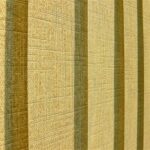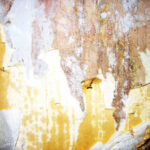I wanted to wallpaper a bedroom in my house in 1989. Unfortunately, my lavish taste clashed with my McDonald’s budget. I looked at magazines, went to DIY stores that advertised wallpaper sales and looked everywhere for something that resembled what I had in mind. I found a lot that seemed to fit the bill for color or patterns, but when it came to price, I swear I heard my wallet cry.
I scoured craft and painting books for ideas about how to paint the room with stripes instead. When I sketched the room using stripes for the walls, the room looked awful. It just didn’t fit.
I watched an old movie that weekend that gave me a hint. The name escapes me, but one scene showed a housewife stenciling a dresser. Her husband noted that she had stenciled everything else in the room, using bright colors as a base. That was it. In Scandinavian countries, bright colors and stencils are used to decorate rooms.
A box in my craft room held dozens of stencils I used on quilts. I taped one on the wall. Nope. Then another. And another. It seemed nearly impossible that with an entire room full of materials and a lifetime of crafting experience was turning up nothing.
At a garage sale, I found a piece of wallpaper that was perfect. The bad thing was, it was only three feet long and two feet wide. It was old, but the pattern was perfect. I asked to buy it. The owner gave me a quizzical look and told me to just take it. I was overjoyed.
What’s the old saying: “One man’s trash is another man’s treasure?” That works with crafters, too.
I carried my prize to my local DIY store and matched the colors in the paper. I dug out my stenciling materials and cut templates. At the craft store, I gathered the rest of my supplies.
I’ll show you how I did it here.
You will need:
- · Stenciling material
- · Pens and pencils for marking
- ·(if necessary)
- · Rulers and tape measures
- · Paintbrushes for the walls and the stencils
- ·:
I took my wallpaper piece to my DIY store and had them match the colors. I knew the measurements for the walls, so the salesperson could help me determine how much to buy.
I decided that I would not match the patterns in the wallpaper with the same color. I chose a contrasting color instead. This would tie the curtains I had made into the décor.
A carefully guarded notebook held all the information of which color went where and on what.
Step Two:
In quilting, you need to determine where a pattern repeats. This helps to make stencils that allow you to mark the fabric pattern quickly.
I used the ruler and drew a mark through two points that would ensure the pattern would repeat easily. Taping the stenciling materials together gave me a larger template.
Step Three:
I weighed the wallpaper piece down flat and carefully traced the pattern on the stencil. I marked the flowers, stars, circles and all the other designs I wanted to stencil. I also marked the vertical lines so I could keep everything straight when I placed the stencil on the wall.
Take your time with this step. Accuracy ensures a better product in the end.
I carefully cut out the stencils.
Step Four:
The testing process was just as intense. This is the point where you can still turn things around or change things.
I painted a piece of plywood with primer and the base coats. Since my wallpaper appeared to use two different colors as a base, I had to paint the wood with special rollers. Match this base coat first. Or create your own.
Next, I taped off and painted the stripes. Some stripes were accented with metallic-gold paint. I learned a trick from a friend of mine who paints portraits. I held a stick on the board against dry paint. My painting hand rested on the stick instead of the work. It really works. It helped me to hold the brush steady.
Step Five:
When the base coat and stripes were done, I placed my stencil on the board. All the stripes lined up. I taped the stencil in place and began to stencil the board. The work went quickly.
When I was finished, I allowed the piece to dry. It looked great. I took it into the bedroom and stood it against the primed walls. I held up the curtains next to it, and placed a dresser I had refinished next to it. Perfect.
Step Six:
Now for the fun part. I painted the room with the base coats, added the stripes and finalized everything with the stenciling.
I had a party in my house and showed the room to my friends. Everybody wanted a room with the same wallpaper. When I laughed, I showed them what I had done. A friend borrowed my wallpaper sample. She found out it was nearly a hundred years old and no one made it any more. If I had to hire a professional company to reproduce it, the cost would have been prohibitive.
Since her husband was a professional painter, she showed everything to him. He bought my stencils, materials and the original sample board. That cut the cost of my project considerably. I asked him how much he would have charged me for my room. Three thousand dollars was enough to make me gag; I spent around $250. I’m glad it was a small room. I found out that re-creating and printing the wallpaper would have been around eight thousand. Yikes.
He now makes money by imitating old or expensive wallpaper for clients. Fortunately, I can afford to work for myself. I can’t afford him.
This will work perfectly in any room in the house, dorm room, apartment, RV or campervan. Furniture can be painted or accented to create a room that looks like everything was custom designed.
For parties, you can paint inexpensive quarter-inch plywood or the back of paneling and tack it to walls. When you move, you can take your wall covering with you. That worked for homeowners in the 19th century. Some things never go out of style.
Source: The author of this article has over 40 years of experience in diverse forms of DIY, home improvement and repair, crafting, designing, and building furniture, outdoor projects, RV’ing and more.
Source: Deborah Baldwin, “How To Create Faux Wallpaper With Paint,” This Old House website, no date given





